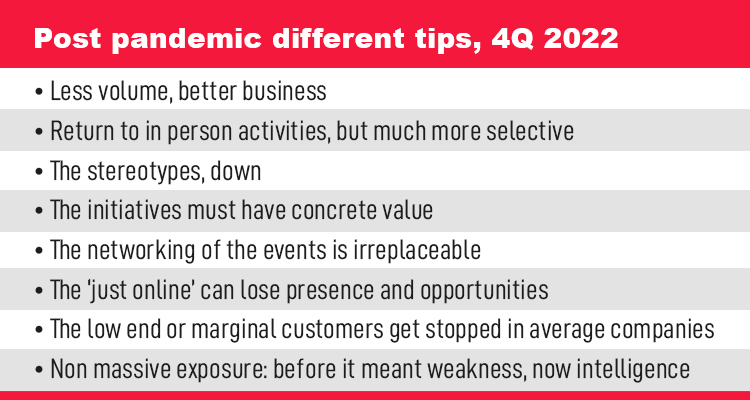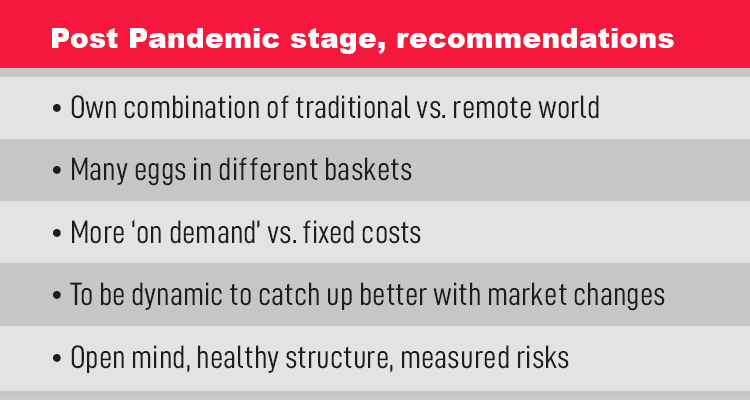Since the Covid-19 appeared, everyone took time to imagine how the post pandemic market would be. The most radical ones thought a disruptive world, with everything online or on the distance, with ‘cloud’ or ‘futuristic’ initiatives turning to real. Later, when the pandemic was maturing, many people went to the opposite, took phobia to online and imagined a full return to the in-person events and manners. At the end, the post pandemic market is a mid-point between these two extreme views, but above all it has its own rules quite different from expected, so it is important to pay attention to them.

There is a return to physical activities, of course. But these ones now are much more selective than before, they run just when they provide touchable value. The typical example: a business executive now develops all his/her one-to-one meetings by videocall, and leaves for in person, the events and strategic meetings that carry special importance.
The events are back because the networking they generate, can’t be obtained virtually for far. Never with its variety and intensity. The phrases we heard are true, as ‘In 2 days at this event, I learnt more and got more leads than in six months of videocalls’. And there are people so used to moving online, that believe in-person events are not necessary any more, but they usually lose presence and opportunities.
The first big difference of the post pandemic market from expected, is the volume. What before was 10, now is 6. Who got 20 deals per event, now gets 12 – 13 for example. But if own business evolves well, perhaps those agreements are more useful than former 20, because they are healthier and more profitable.
Another tip is the reduction of the small, marginal business for the average players. Its low-end customers got damaged with the pandemic, or now are more conservative. It would happen a natural depuration for both sides. Too, the fall-down of the stereotypes. In the past, many actions were made because ‘Everybody does them’ or because ‘if not, you are not in the market’. The blackouts, the videocalls, the new rules, made that many ‘essential’ actions are not ‘essential’ anymore, as to invest thousands of dollars in a big booth or in a massive campaign. This before was a sign of weakness, now is seen as optimization, intelligence.
At the content market, there is a clear reduction in the volume of streaming platform productions, which till few time ago were providing furious energy to the producer houses. In many international productions poles —Spain, CEE, Southest Asia, Mexico— the production levels doubled in 2021 their 2019 numbers. Today in all these regions the production is lower, but this also can be understood as a logical reduction ofthe bubble created above real market needs.
At the technology market, there is a big trend towards cloud, to change CAPEX (own structure with regular costs) per OPEX (outsourcing, scaled costs on demand). And all about more software, more services, dynamic and collaborative structures, are on the move. There is also less volume of deals, with depuration by margin health or focus.
The post pandemic market can be hard for many companies, as the segments which suffer reduced demand. What suggestion can be made to them? As usual, to distribute eggs in many baskets, especially facing emerging segments, to be on first places when they grow.

This post pandemic stage is not good or bad, is just different, and it is important to adapt oneself as for the previous times. Theright combinationof the elements we’ve been listing, depends on every company: more online, more outsourcing, etc. Everything is very changeable at the same time. What works today can fail in few months, as it happened during the pandemic when we were below the blackouts, then with some openings and then with everything opened. It is important to check own business periodically and to launch innovationsfrom time to time, to guessthe market evolution and its opportunities.
The latter takes to a last but important tip: in these times it is easier not to notice business news, comparing to pre pandemic times, when everything was most exposed in known sides. Now when many facts happen online, a company can be aisled without knowing. It is important to be open-minded, healthy and dynamic structured, to run measured risks, to be always around a positive position.
Spanish Version
Parece el mismo, pero es diferente: el mercado post pandemia
Desde que saltó el Covid-19, uno se imaginaba cómo sería el mercado post pandemia. Los más radicales pensaron en un mundo disruptivo, donde casi todo sería por zoom o a la distancia, y lo que se proponía como ‘cloud’ o ‘futurista’ sería realidad. Después fue avanzando la pandemia, y se pasó al otro extremo: muchos tomaron fobia a lo virtual y clamaron por la vuelta a los eventos, a todo lo tradicional. Al final, el mercado post pandemia es una combinación de estos dos puntos de vista, pero sobre todo tiene sus reglas propias distintas a lo esperado, que vale prestarles mucha atención.
Hay un regreso a las actividades tradicionales, físicas, sin duda. Pero estas son mucho más selectivas que antes, y se llevan adelante sólo cuando tienen valor. Lo típico: un ejecutivo que antes no hacía ninguna video llamada y era todo físico, ahora hace todos los encuentros uno a uno por zoom, y deja para lo presencial los eventos o reuniones estratégicas, en general con mucha gente, a las que les asigna acento o importancia.
Los eventos vuelven porque el networking que aportan, no puede ser logrado en lo virtual. Nunca en su misma variedad e intensidad. Son ciertas las frases que se dicen, que en 2 días de un evento físico, se logran más leads y se aprende más del mercado que en seis meses de videollamadas. Están los que se acostumbraron tanto a moverse a la distancia, que creen que se puede reemplazar lo presencial, pero terminan perdiendo oportunidades.
La primera diferencia de la post pandemia frente al post que se esperaba, es el volumen. Lo que antes reunía 10, ahora reúne 6. El que lograba 20 acuerdos para un evento, ahora logra 12 por ejemplo. Pero si transita bien su evolución de negocio, esos de menos valen bastante como el conjunto anterior, porque son de mayor cuerpo y más rentables.
Un rasgo claro de esta nueva etapa es que se reduce mucho el ‘chiquitaje’, los clientes muy low end o marginales, porque quedaron golpeados por la pandemia y/o se han vuelto más conservadores. Un depurador natural para ambos lados, en resumen. Otro es la caída de los estereotipos. Antes un gran conjunto de cosas se hacían ‘porque todos lo hacen’, ‘porque si no uno no se ve en el mercado’. Los aislamientos, los zoom, las nuevas reglas, hacen que mucho ‘esencial’ pueda dejar de serlo, como invertir en un gran booth en una feria. Antes se hubiera visto como debilidad, hoy es optimización, inteligencia.
En el mercado de contenidos audiovisuales, hay una clara baja en los volúmenes de producción de las plataformas de streaming, que venían proveyendo combustible furioso a las casas productoras, al grado que en muchos polos de producción —España, México, sureste asiático, CEE— se habían duplicado los niveles de producción de 2021 vs. los de 2019. Hoy en todos lados se produce mucho menos, de mínima al 50%, aunque esto puede entenderse también como reducción propia de una burbuja que venía demasiado inflada.
En el mercado de tecnología, hay una gran tendencia al cloud, a cambiar CAPEX (estructura propia con gastos fijos) por OPEX (gastos escalables según consumo). Y todo lo que se venía anticipando antes de la pandemia sobre más software, más servicios, estructuras dinámicas y colaborativas está en su esplendor. También hay menos volumen de negocios, con depuración según salud de márgenes o foco de acción.
El mercado post pandemia puede ser muy duro para muchos, sobre todo aquellos como las casas productoras que se habían acostumbrado al boom de los streamers. ¿Qué respuesta se le puede sugerir a estos players? Lo de siempre: distintos huevos en distintas canastas, previendo lo que puede subir para estar entre los primeros en la ola cuando esté subiendo.
Esta nueva etapa no es ni buena ni mala, es diferente, y hay que adaptarse como a cada una de las anteriores. La mezcla de todo lo que estuvimos señalando varía en cada uno, se debe buscar el mejor coeficiente propio entre online, físico, outsourcing, etc.
Todo es muy cambiante a la vez. Lo que resulta hoy puede no serlo en pocos meses, como durante la pandemia que se pasaba del aislamiento completo al comienzo de las aperturas y luego la masificación de estas, con los perfiles diferentes. Vale hacerse replanteos por semestre y seguro cambiar cosas para ver si uno no está perdiendo negocio sin darse cuenta.
Esto último da pie al último detalle clave: en estos tiempos uno no se da cuenta fácil de las cosas, como era más fácil antes del covid, donde todo estaba mucho más expuesto y jerarquizado. Estando online mucho nuevo no se capta, o sólo aparece de a ratos. Mente abierta, estructura sana y dinamismo, correr riesgos medidos, para estar siempre bien parado.
Nicolás Smirnoff

